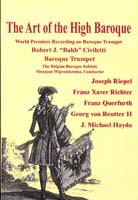
The Art of the High Baroque. World Premiere Recording on Baroque Trumpet. Robert "Bahb" Civiletti, baroque trumpet. The Belgian Baroque Soloists, Niranjan Wjewickrema, Conductor; Marie Haag, Catherine Meeus, baroque violins; Rainer Ardt, baroque viola; Eve Francois, baroque cello; Benoit Vanden Bemden, baroque bass viol; Sopie van Heerle, harpsichord; Stefanie Troffaes, Wim Vandenbossche, transverse flutes; Mark De Merlier, Frank Clarysse, natural horns; Alain De Rijckere, baroque bassoon. CD program notes, Edward Tarr. Buccina Cantorum Recordia BCR 3313114. Recorded 10-13 April 2007. www.tce-studio.com
This latest CD by Robert "Bahb" Civiletti is nothing short of remarkable. All six compositions on this recording are listed as “world premiere recordings on Baroque trumpet” and an examination of Lowry’s International Trumpet Discography bears out this claim. The works in question are Trumpet Concerto in D by Joseph Riepel (1709-1782), Trumpet Concerto in Eb by Franz Querfurth (fl. Mid-18th century), Trumpet Concerto No. 1 in C, Trumpet Concerto No. 2 in D by Georg von Reutter II (1708-1772), Trumpet Concerto in D by Franz Xaver Richter (1709-1789), and the Trumpet Concerto No. 1 in D by J. Michael Haydn (1737-1806). In some sense these works are like the famous Haydn Trumpet Concerto but on steroids. All are unbelievably virtuosic and demanding. Ed Tarr, in his thoughtful CD program notes states that the Michael Haydn D-major trumpet concerto has the distinction of presenting the "world record" height of sounding A above high C, in bar 41 of the first movement. The Richter concerto ascends to high concert G.
That this is the first time anyone has recorded these demanding pieces on baroque trumpet is no surprise and certainly puts Bob Civiletti in a very special category. Civiletti started his trumpet career as a lead jazz and commercial player and went on to help develop the "Tongue-Controlled Embouchure (TCE)" technique with the well-known “chop doc” Jerome Callet. His fantastic ability to control the very extreme high tessitura on the trumpet serves him well with this repertoire. However, these pieces are not played like a lead jazz trumpeter. Civiletti plays this repertoire with a great deal of style and sensitivity and the Belgian Baroque Soloists matched him in this regard.
The cadenza in the second movement of the Joseph Riepel D major concerto is one of the very few written out by the composer of a trumpet work of this period. It is short and has little thematic material from the composition. It is more of a brilliant flourish than a melodically developed cadenza as found in other repertoire. Civiletti uses this as a model for cadenzas in the other works. The cadenza played in the first movement of the Richter D major concerto echoes the extreme passage to the high G above C ending with an arpeggio down to the third harmonic, G below the staff.
This is somewhat of a landmark recording, the absolutely most demanding Baroque trumpet repertoire well played on a baroque trumpet. Bob Civiletti certainly sets the bar several notches higher for future players. Given the outstanding aspects of the performance one is almost hesitant to remark on any shortcomings. No landmark efforts are flawless. Certain extreme passages with difficult leaps are occasionally attacked in a less than perfect way and tone quality is sometimes affected. However, 100% technical perfection is not to be expected on a maiden voyage. Bob Civiletti performs with remarkable skill and musicianship and has shown the brass world that this repertoire is approachable on Baroque trumpet. The gauntlet has been thrown down. Having given us a view of the possibilities, maybe in the next generation trumpeters will perform these works on a natural trumpet with no vent holes and come even closer to a perfect performance. Until then, this recording is the closest we will come to knowing the sounds of the likes of the great Austrian trumpet virtuosos of that era such as Johann Heinisch (fl. 1725-51) and J.B. Resenberger (c. 1700-1781).
-- Jeffrey Nussbaum



